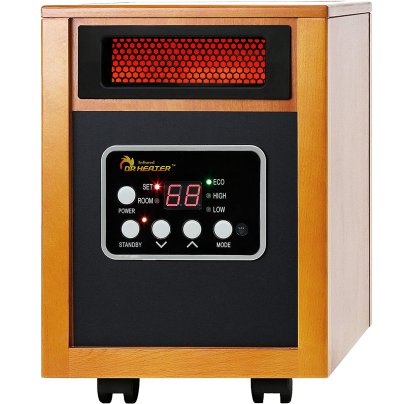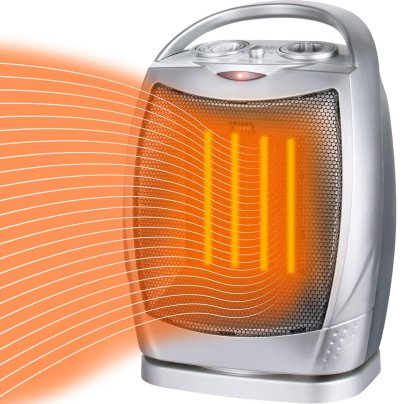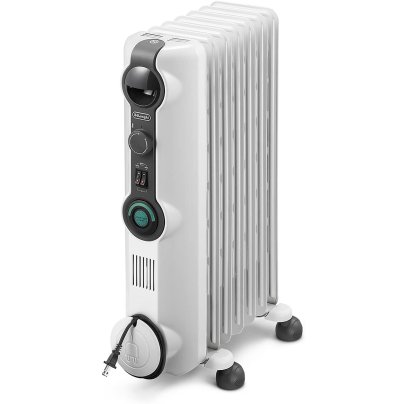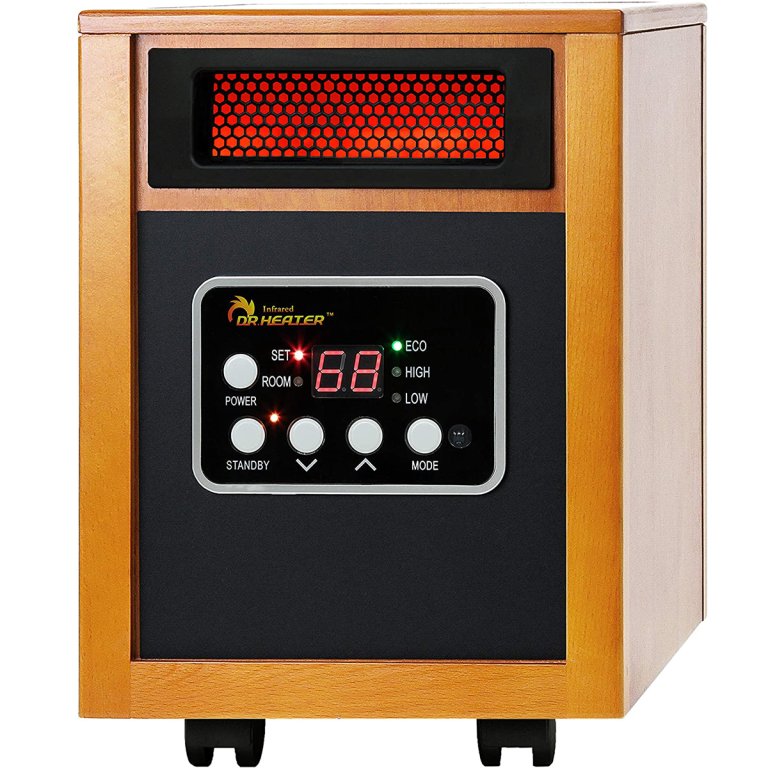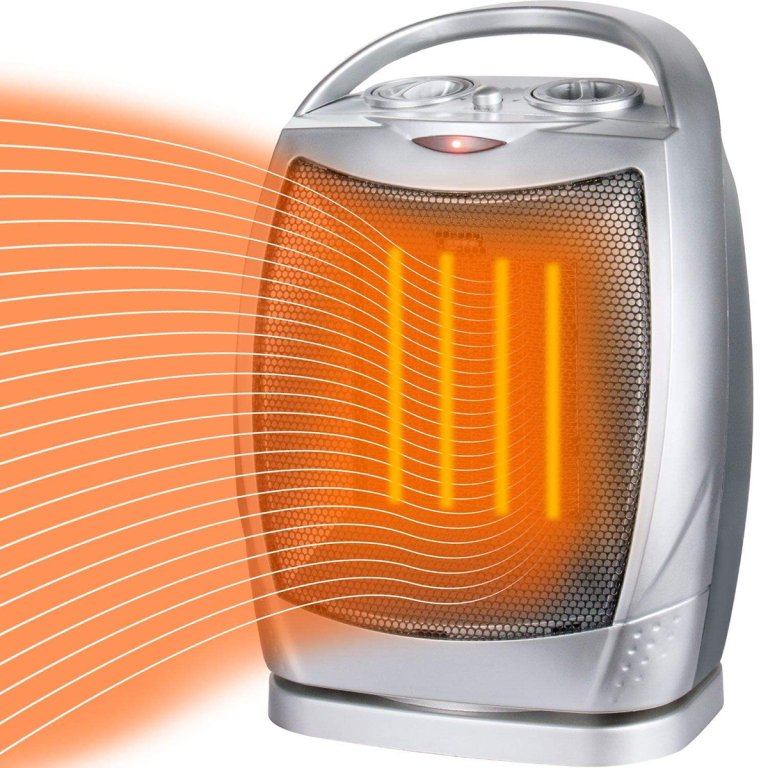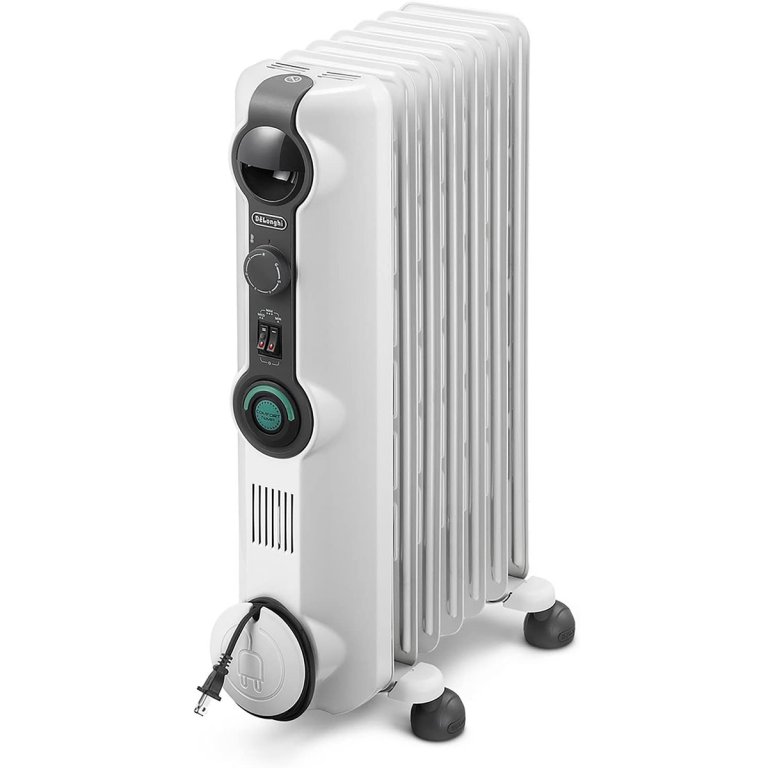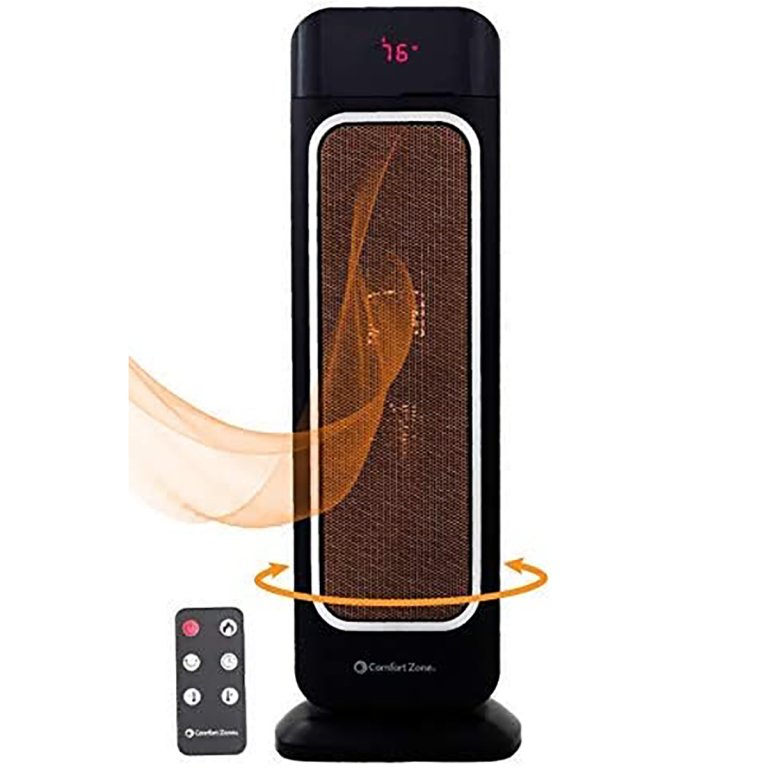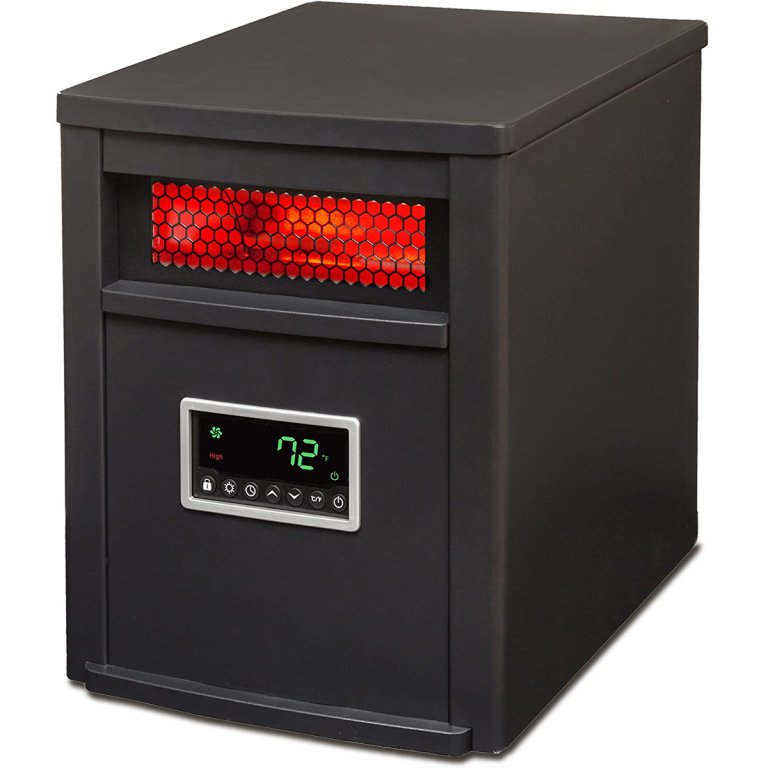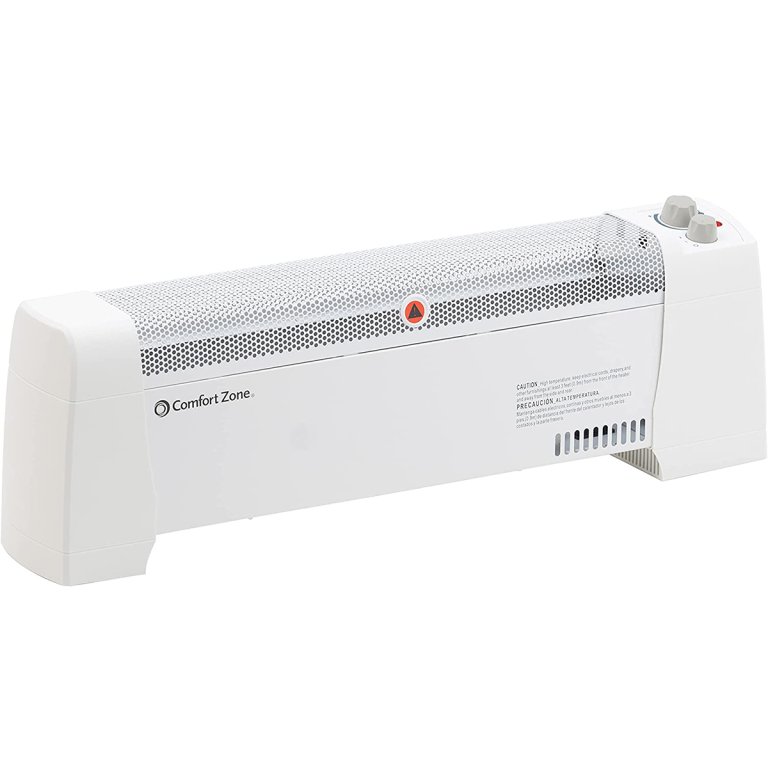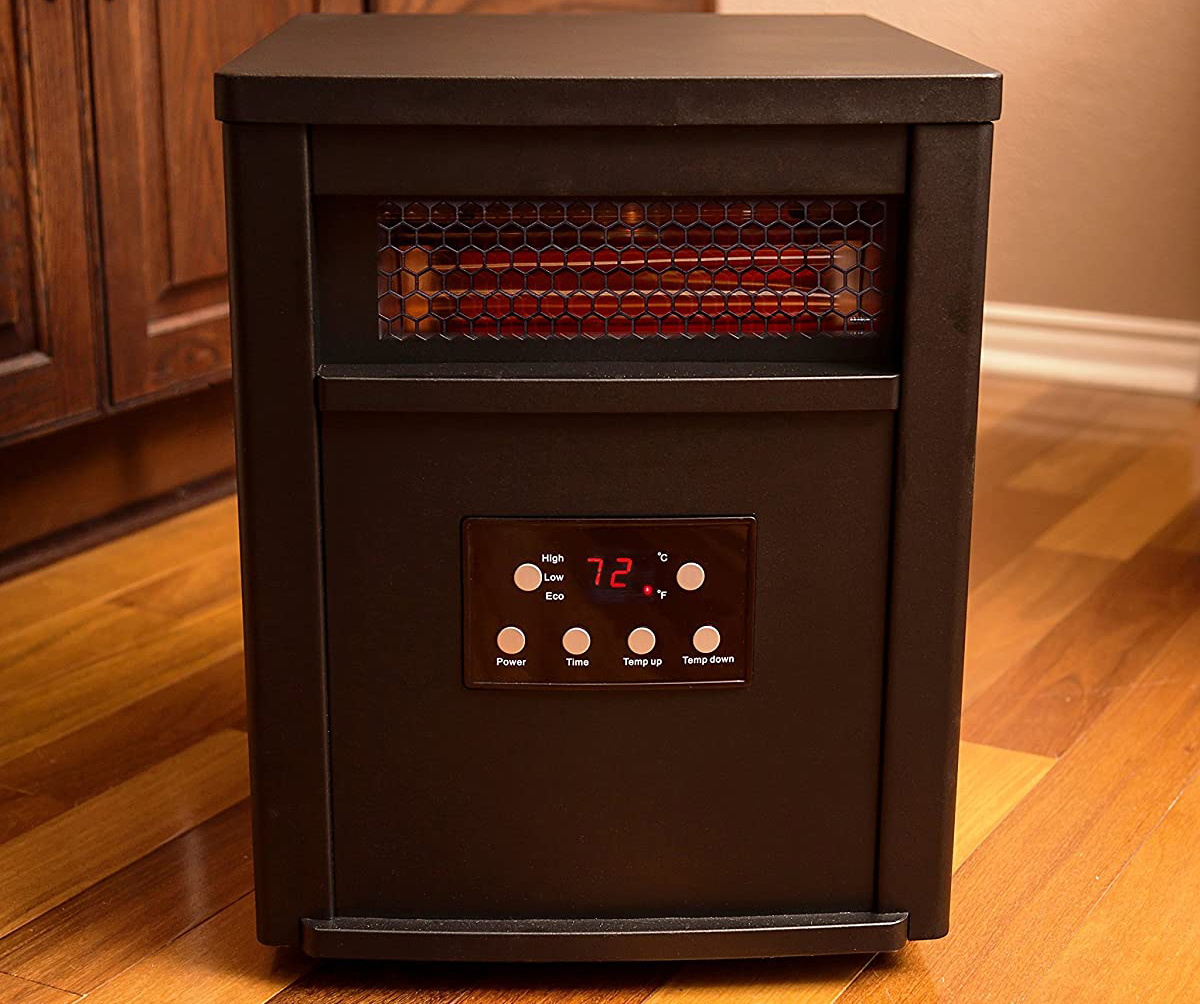
We may earn revenue from the products available on this page and participate in affiliate programs. Learn More ›
Even if a basement is only used for storage, leaving it unheated can promote mold growth on books, clothes, and other materials. And, should the pipes freeze in winter, there could be flooding—and an expensive repair bill.
For those who use their basement as a home office, movie room, workout area, or other activity space, warmth is even more important. Unfortunately, a basement often isn’t on the existing HVAC system, and adding it can be prohibitively expensive.
Space heaters are an efficient, cost-effective solution to taking the brrr out of your basement. Read on for helpful intel on what to look for in the best space heaters for basements and check out some excellent options, one of which is likely to suit the size of your basement and how you typically use it.
- BEST OVERALL: Dr. Infrared Heater DR-968 Portable Space Heater
- BEST BANG FOR THE BUCK: GiveBest Oscillating Portable Heater
- BEST RADIATOR: De’Longhi ComforTemp Full Room Radiant Heater
- BEST CERAMIC: Comfort Zone Oscillating Digital Tower Heater
- BEST SMART: Heat Storm HS-1500-PHX-WIFI Infrared Space Heater
- BEST COMPACT: Lifesmart Infrared Heater with Steel Cabinet
- BEST BASEBOARD: Comfort Zone Convection Baseboard Heater
- BEST STOVE: Duraflame Infrared Quartz Electric Stove Heater
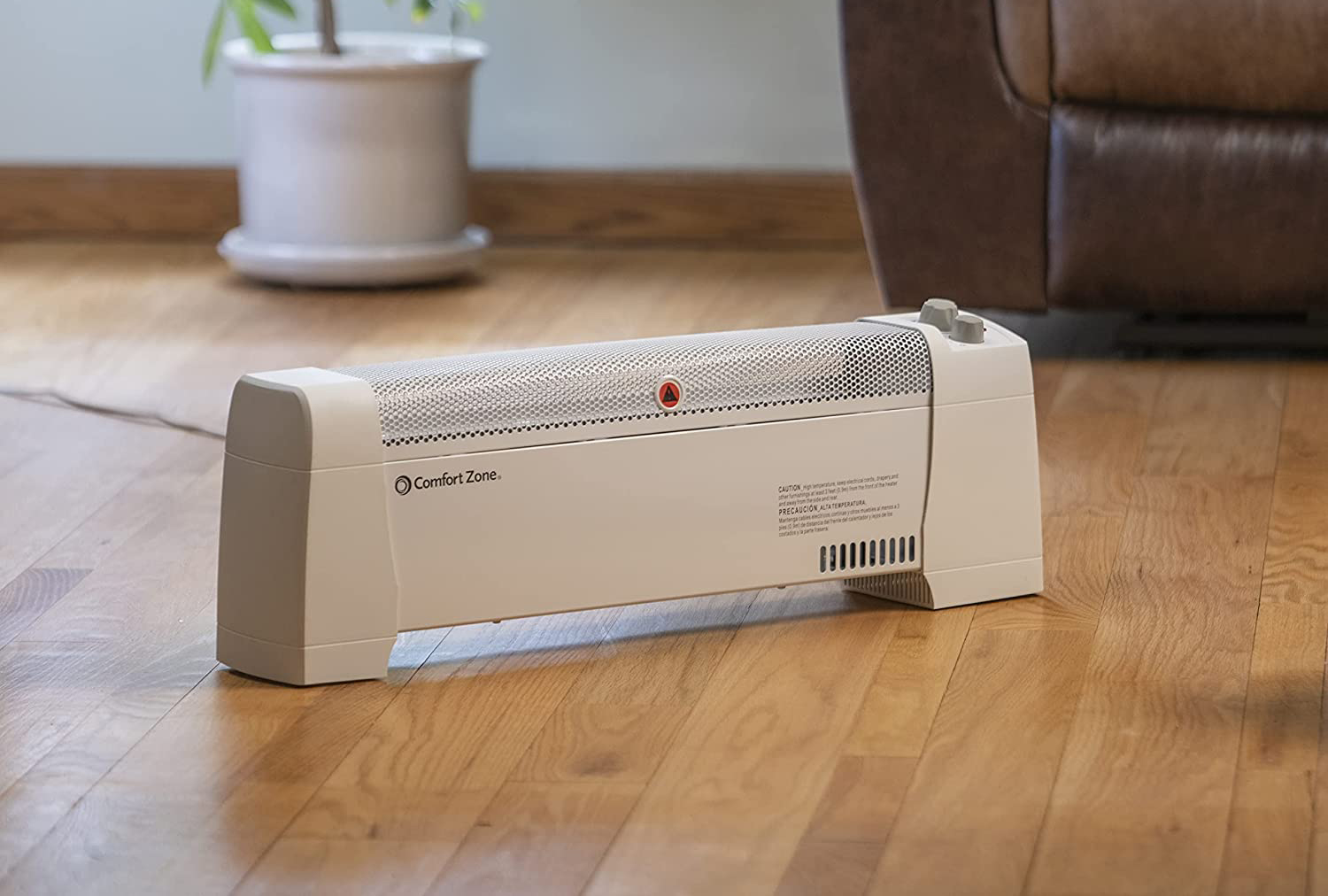
How We Chose the Best Space Heaters for Basements
Basements or basement rooms come in a variety of sizes and are used for a variety of functions. Finding a single best space heater that will meet all these demands is practically impossible, so we wanted to offer a variety of devices, each of which has certain strengths. It’s not just about finding the most powerful basement heater—it’s about finding models that meet the needs of as many different people as possible.
Quality and value were also priorities. Cheap space heaters are widely available, but performance can be disappointing, and many lack the reliability we would expect. Nevertheless, our top picks do include some very affordable models, so there should be something for all budgets.
Our Top Picks
It’s now time to look at real-world examples that illustrate the features discussed so far. Our top picks represent the best space heaters for basements in a number of different categories to provide solutions for most situations.
Best Overall
Dr. Infrared Heater DR-968 Portable Space Heater
Pros
- Precise digital control can be set between 50 and 85 degrees Fahrenheit
- Quiet circulating fan pushes heat throughout large spaces
- Handheld remote manages all settings
Cons
- Premium price compared to other space heaters
- A bit heavy; best left in the same general area
Product Specs
- Type: Infrared and ceramic
- Heat settings: 1,000W; 1,500W; eco mode
- Weight: 24 pounds
The Dr. Infrared DR-968 Portable Space Heater uses what the manufacturer calls advanced dual-heating technology. This combines infrared tubes with ceramic elements to heat large basements quickly.
The digital thermostat allows precise temperatures to be set between 50 and 85 degrees Fahrenheit. Settings are 1,500W for high; 1,000W for low; plus eco mode for maximum energy efficiency. A quiet 39-decibel fan helps push heat around the room. There is a 12-hour timer, and all settings can be managed via the handheld remote control.
The exterior does get warm but not hot, so this Dr. Infrared space heater is safe for use around children and animals. There is overheating and tip-over protection, and the unit is UL listed. At 24 pounds, it isn’t the lightest model, and while it does have casters, they are plastic rather than metal.
Get the Dr. Infrared space heater for basements on Amazon or at The Home Depot.
Best Bang for the Buck
GiveBest Oscillating Portable Heater
Pros
- Light and easy to carry at just under 4 pounds
- Fan-only option for summer makes it useful year round
- Good value for those looking for a personal heater or who have a small basement
Cons
- Fussy tilt sensor can be triggered by carpeted floors; needs to rest on a solid surface
- Not powerful enough to provide sufficient heat for large basements
Product Specs
- Type: Fan-forced ceramic
- Heat settings: 750W; 1,500W
- Weight: 3.59 pounds
Those looking for a portable basement heater at a bargain price should check out this GiveBest model. It is a fan-forced heater with ceramic elements and heat settings of 750W and 1,500W. In summer, the fan can be used on its own to blow air and cool the room. At just 45 decibels, it is quiet enough not to impose.
The GiveBest heater weighs under 4 pounds and has a carry handle molded into the top. It is at its best when used as a personal heater—next to a desk, say—or in small basement rooms. Dials are easy to use, though there’s no accurate temperature setting.
The heater is ETL listed and has both overheating and tip-over protection. However, the latter is operated by a spring-activated button on the base that can sink into deep carpeting, thus producing the same effect as if the heater had tipped and preventing it from turning on. It needs to rest on a fairly solid surface.
Get the GiveBest space heater for basements on Amazon.
Best Radiator
De’Longhi ComforTemp Full Room Radiant Heater
Pros
- ComforTemp energy management automatically maintains room temperature of between 68 and 70 degrees Fahrenheit
- Maintenance-free steel construction is durable and never needs refilling
- Anti-frost setting prevents the basement from dropping below zero
Cons
- Premium price compared to other space heaters
- Occasional leaks reported, an obvious concern
Product Specs
- Type: Oil-filled radiator
- Heat settings: 700W; 800W; 1,500W
- Weight: 22 pounds
Oil-filled radiators often have a reputation for being slow to heat up. The De’Longhi has multiple fins that increase the amount of surface area, making it produce heat much more quickly than traditional models. Plus, the energy is produced steadily rather than in expensive power surges.
While there are three heat settings, two of them—at 700W and 800W—are virtually the same; selecting both produces a maximum of 1,500W. A key feature of the De’Longhi radiator is the ComforTemp setting that will automatically maintain room temperature at between 68 and 70 degrees Fahrenheit. A six-position knob offers further temperature control. There’s also an automatic anti-frost setting to prevent the basement from dropping below zero.
The main construction is steel for durability and, as a sealed unit, it never needs refilling. There have been occasional reports of oil leaks, however. The De’Longhi radiator has overheating protection and is UL listed.
Get the De’Longhi space heater for basements on Amazon.
Best Ceramic
Comfort Zone Oscillating Digital Tower Heater
Pros
- Precise temperature setting can maintain the temperature automatically to save energy
- 8-hour shutoff timer and handheld remote control
- Oscillates in a 70-degree arc to distribute warmth over a wider area
Cons
- Inconsistent quality control; occasional reports of malfunction
- Remote batteries not included
Product Specs
- Type: Fan-forced ceramic
- Heat settings: 800W; 1,000W; 1,500W; eco
- Weight: 7 pounds
Fan-forced ceramic heaters produce almost instant heat, but folks not sitting directly in front of them don’t get the full benefit. To provide warmth over a wider area, this ceramic Comfort Zone tower continuously oscillates through a 70-degree arc.
There is a digital thermostat, and output can be set at 800W; 1,000W; 1,500W; or eco. The latter will maintain the desired temperature automatically, thus saving energy. There’s also an 8-hour shutoff timer. Everything can be controlled via a handheld remote (batteries not included).
The Comfort Zone Oscillating Digital Tower Heater is ETL listed, with overheating protection and a tip-over sensor. It is lightweight and easy to move around. There have been occasional reports of malfunctions, but nothing that suggests a consistent problem.
Get the Comfort Zone Oscillating space heater for basements on Amazon or at The Home Depot.
Best Smart
Heat Storm HS-1500-PHX-WIFI Infrared Space Heater
Pros
- Wi-Fi or touch-screen control allow setting to be adjusted from anywhere
- Space-saving wall mount; converts to floor unit by simply adding feet
- Safe cool-touch exterior and tip-over protection
Cons
- Feet for floor mounting sold separately
- Premium price compared to other space heaters
Product Specs
- Type: Infrared
- Heat settings: 1,500W; eco
- Weight: 9 pounds
Space heaters tend to obstruct traffic or hog floor space, so this wall-mounted Heat Storm Infrared model is a smart solution. Even smarter, its Wi-Fi control allows settings to be adjusted from anywhere via the free smartphone app. And that’s just the beginning of what this feature-packed model has to offer.
An easy-to-operate touch screen accesses the digital thermostat and timer. Normal output is 1,500W, but eco mode reduces power to match the desired temperature. The fan runs at just 40 decibels, which is described as “library quiet.” There’s also an air filter to capture dust and dander.
The Heat Storm is ETL listed and remains cool to the touch. It also has tip-over protection, which would apply if the unit is used as a floor-standing model; conversion to floor standing is simply a matter of adding feet, though surprisingly these are not included.
Get the Heat Storm space heater for basements on Amazon or at The Home Depot.
Best Compact
Lifesmart Infrared Heater with Steel Cabinet
Pros
- Tough steel case but compact and convenient size
- Full 12-hour timer
- Remote control
Cons
- Not ETL or UL listed
- Batteries for remote not included
- Heavy for its size; inconvenient to move
Product Specs
- Type: Infrared
- Heat settings: 1,000W; 1,500W; eco
- Weight: 20 pounds
Space heaters almost invariably get bumped and knocked from time to time, which is why tip-over sensors are such an important safety feature. However, physical damage can still occur, which might stop the heater from working. That’s unlikely to happen with the Lifesmart infrared heater, thanks to its tough steel case. Yet, with its modest dimensions of 13.1 inches long by 16 inches wide by 16.5 inches high and neutral gray color, it is neither imposing nor unattractive.
A digital thermostat runs in conjunction with power settings of 1,000W; 1,500W; or eco mode, maintaining a constant 68 degrees Fahrenheit. There’s also a 12-hour on-and-off timer. Settings can be controlled via the handheld remote provided (batteries not included). At 20 pounds, it isn’t the most portable unit, so don’t be fooled by its modest size. This model is neither UL nor ETL listed.
Get the Lifesmart space heater for basements on Amazon.
Best Baseboard
Comfort Zone Convection Baseboard Heater
Pros
- Discreet low profile and silent operation provide non-intrusive heat
- Features easy-to-use controls, overheating and tip-over protection, and a cool-touch body
- Modest cost yet still ETL listed
Cons
- No economy mode or timer
- Not for large spaces
Product Specs
- Type: Convection
- Heat settings: 750W; 1,500W
- Weight: 6.2 pounds
Don’t want to be disturbed by the presence of a space heater? Consider the Comfort Zone Convection Baseboard Heater. It’s not only low profile but is also completely silent as there is no fan. It isn’t the fastest heater, but a choice of 750W or 1,500W output produces gentle heat for modest-size spaces.
Thermostat and power controls are simple knobs, making the Comfort Zone baseboard heater one of the easiest units to operate. However, there is no economy mode or timer. It is ETL listed with a cool-touch body and has both overheating and tip-over protection.
The Comfort Zone baseboard heater is quite basic, but the price is very competitive, and there are few reports of problems. An inexpensive plug-in timer could be added if desired.
Get the Comfort Zone baseboard space heater for basements at Walmart.
Best Stove
Duraflame Infrared Quartz Electric Stove Heater
Pros
- Attractive traditional style is both efficient and attractive
- Flame effects can be adjusted for color, brightness, and speed
- Controls are cleverly hidden behind the door panel, or the unit can be remote-control operated
Cons
- Expensive compared to other space heaters
- Top can get hot; can’t be used as a shelf
Product Specs
- Type: Infrared
- Heat settings: 1500W
- Weight: 30 pounds
Most basement heaters aren’t noted for their style, but that’s not the case with this Duraflame stove, which is both efficient and attractive. The steel-and-glass construction mimics a traditional log stove, and flame effects can be adjusted for color, brightness, and speed.
There is a single power setting with a digital thermostat to provide precise adjustment as well as an 8-hour shutoff timer. Controls are cleverly hidden behind the door panel, so there’s nothing to spoil the appearance, and a remote is also provided.
The Duraflame stove has overheating protection but does not appear to be ETL or UL listed. It is expensive but may be a worthy investment for a larger basement as, according to the manufacturer, it can heat an area of up to 1,000 square feet.
Get the Duraflame space heater for basements on Amazon or at Target.
A Recap of Our Recommendations
- BEST OVERALL: Dr. Infrared Heater DR-968 Portable Space Heater
- BEST BANG FOR THE BUCK: GiveBest Oscillating Portable Heater
- BEST RADIATOR: De’Longhi ComforTemp Full Room Radiant Heater
- BEST CERAMIC: Comfort Zone Oscillating Digital Tower Heater
- BEST SMART: Heat Storm HS-1500-PHX-WIFI Infrared Space Heater
- BEST COMPACT: Lifesmart Infrared Heater with Steel Cabinet
- BEST BASEBOARD: Comfort Zone Convection Baseboard Heater
- BEST STOVE: Duraflame Infrared Quartz Electric Stove Heater
Types of Space Heaters for Basements
The term “space heater” covers a variety of different devices and a number of different heating technologies. A basic understanding of how the heat is generated and delivered will help you choose the most appropriate space heater for the way you use your basement.
Fan Forced
Fan-forced space heaters blow air across a heating element and out into the room. They are often relatively inexpensive devices, and while they come in a range of sizes, they are usually light and very portable. They are perhaps the best space heater for personal use, but they are not very efficient for large areas.
Radiator
Oil-filled electric radiators are proven technology that has been around for over a century. Although somewhat slow to warm up, they retain heat longer when turned off. With no naked heating element, they are also very safe. They are often a bit heavy, but most have wheels for easier mobility.
Convection
Convection refers to the process of heat transfer by the bulk movement of molecules within such fluids as gasses or liquids. Convection heaters can run on propane, oil, kerosene, or electricity, and while they come in a variety of styles, basic units simply heat the surrounding area. Like radiators, they are slow to warm up, but they can eventually heat a fairly large space. Many fan-forced space heaters have a convection heat source.
Infrared
Unlike standard heaters that warm the air in the room, infrared (also known as radiant) technology warms objects—and that includes people. Users will feel the effect of an infrared heater almost immediately. Though they are very energy efficient, these heaters don’t dry the air like standard models can. And, while they may save on an energy bill, the initial cost for an infrared heater can be higher than other types of space heaters.
Ceramic
Ceramic heating elements have now largely replaced bars wound with wire that were popular in electric space heaters for many years. The ceramic plates, often found in fan-forced space heaters, warm up faster and last longer than their predecessors. The term “positive temperature coefficient” (PTC) is sometimes used to describe ceramic heating elements.
Micathermic
Micathermic space heaters combine convection and radiant principles in a single unit. The result is very rapid heating combined with low energy consumption. They are often recommended as the best electric heater for large basements, but right now micathermic space heaters are considerably more expensive than other types.
Baseboard
As the name implies, baseboard heaters are low-profile units generally intended to be positioned against a wall. Many are electric convection heaters, while some incorporate a fan to blow air across hot coils, and still others are radiant models. Baseboard heaters are effective in medium-size to large basements.
What to Consider When Choosing the Best Space Heater for Basements
In addition to the way a space heater generates warmth, other factors go into how appropriate a particular model is for a basement space and the way that space will be used.
Power Source and Heating Capacity
While gas and kerosene space heaters are available, electricity is by far the most popular choice. It’s clean and simple, there are no unpleasant fumes, and, generally speaking, it is very safe.
Heating capacity is specified in watts (W). Space heaters may have single or multiple settings, the latter intended to save energy. As a rough guide, experts recommend 10W per square foot. So, if a basement is 100 square feet, it would need a 1,000W heater.
Size, Style, and Portability
Physical size and appearance tend to be more important in a basement that’s used regularly. The smaller the size, the less the unit will impact the decor of the space, yet some units are more visually appealing than others. They vary from plain and functional, to sleek and modern, to those that mimic the look of a real fireplace or stove.
Portability will be vital if the heater will be moved around to different parts of the basement, rather than one that is permanently situated. Lightweight models needn’t be just for the basement but can be used around the house to provide heat where ineeded.
Safety Features
While electric space heaters are inherently safer than those that produce a “live” flame, most incorporate additional safety features. Overheating sensors are common, turning the device off if vents get blocked or the temperature rises beyond a preset level. Tip-over sensors automatically shut the heater off should it get knocked down. Some models have cool-touch exteriors, and a few have child locks to prevent accidental operation.
Many space heaters are listed by Electrical Testing Laboratories (ETL) or Underwriters Laboratories (UL). These are internationally recognized independent testing standards that guarantee certain levels of safety. However, both are voluntary and costs are involved, so not all manufacturers submit their equipment. While it is reassuring to see, not having either recognition does not necessarily mean a device is dangerous.
Additional Features
The best space heaters for basements incorporate a number of user-friendly features.
- Thermostats are one of the most popular and, once set, will often automatically maintain a chosen temperature.
- Timers are another convenience—most allow a particular shutoff period to be set, but some offer more versatility.
- Handheld remote controls are a convenient way to allow adjustments to be made from across the room.
- Wi-Fi connectivity allows various control functions to be accessed via smartphone or tablet from almost anywhere.
Safety Tips for Using Space Heaters for Basements
Any source of heat has the potential to cause a fire. While many space heaters have built-in safety features like tip-over sensors, there are a few simple steps you can take to make sure your home is safe.
- The Consumer Product Safety Commission and the National Fire Protection Association both recommend a minimum 3-foot gap between the space heater and any other object.
- Turn off and unplug the space heater when not in the room. Many space heaters produce rapid warmth so there’s little need to leave them on when the basement is not occupied. Turning them off will also save money.
- If the space heater has a hot surface that could burn people or pets, situate it away from places that get a lot of passing traffic. Alternatively, choose a wall-mounted model that can be raised out of the way.
- Only plug space heaters directly into wall sockets, not into an extension cord or power strip, as these may overheat.
- Ensure that there’s a functioning smoke alarm in the room.
FAQs
The sections above contain plenty of useful information to help you choose the best space heater for your basement. Below, however, we’ve culled some of the most common questions about these devices and provided simple, straightforward answers to make your decision easier.
Q. Can I use a space heater in the basement?
Absolutely. The space heaters above offer a range of cost-effective ways to heat a basement.
Q. Why should I use a basement space heater?
A cold basement will drain heat from the rest of the home. A basement space heater can also help prevent pipes from freezing and discourage mold growth.
Q. How much space is needed around a space heater?
Most manufacturers and safety organizations recommend a clear space of around 3 feet, though you should always check each device. While some are safe to put on or against a wall, others will need clearance there as well.
Q. Should I use more than one space heater for my basement?
It depends on the size of the basement and how it is used. One space heater can often be enough to maintain temperature and prevent problems. Supplementary heating may be required if the area is used for work or leisure.
Q. What is the most efficient way to heat a basement?
All kinds of heaters can be efficient at heating a basement, but it’s important to choose what’s appropriate for the space and function. The guide above will help you find the best basement heater for various uses.
Q. How can I heat my basement inexpensively?
Heaters that produce radiant heat are among the cheapest ways to heat a basement. Thermostatic control is important so energy isn’t wasted. Consider the space involved. Heaters that have to work at peak performance all the time will be more expensive to run than those that are running at 50 percent capacity, for example
